I just like hearing what people have and like.
I've owned a lot of tube stuff (still tube) and how found certain solid state that gets me the musicality I like from tubes, along with the bass impact / ease of use / lack of noise.
TubesAround 20 years ago I heard Joule Electra VZN OTL amps at the CES show with Merlin VSM speakers. I already owned the Merlin VSMs, and they were picky about gear... an aside... the reason WHY they are picky about gear is know to me now, and Danny is getting ready to fix it. So, the Joule VZN amps are just magic. OTL... the tube is connected to the driver. The midrange bloom is incredible. There was another feature... dialing in the amount of feedback. The magic happened with overall feedback was dial as low as possible. The other features of the amp is that is would heat a gymnasium, and starting it up as like firing up a steam driven locomotive... coal fired furnace and all. It doesn't have a "power switch", but a Variac... you turn a big dial to start applying current to the tubes and what the levels come up on the meter. It is an "enthusiast" thing... but again... MAGIC.
Here is my Joule Electra VZN-80 OTL amp with the hood off...
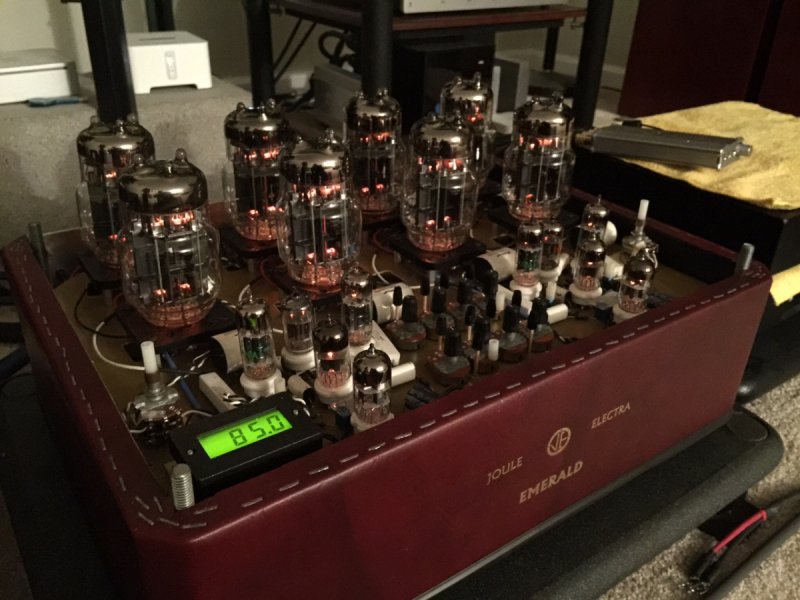
For front end I have (not in use) Joule LAP 150 preamp. Dual box unit, point to point wired... all tubes.
Joule Electra LAP150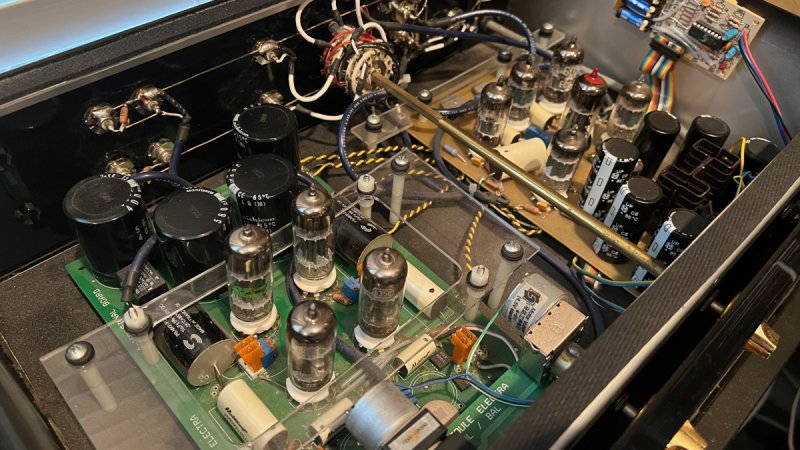
I have also played with some hybrid stuff, including an (unobtainable) Joule Electra VAMP integrated. Tube front end, Mosfet output. Point to point wired. Very little overall feedback... Damping Factor 13. Sounds so sweet!
Joule Electra VAMP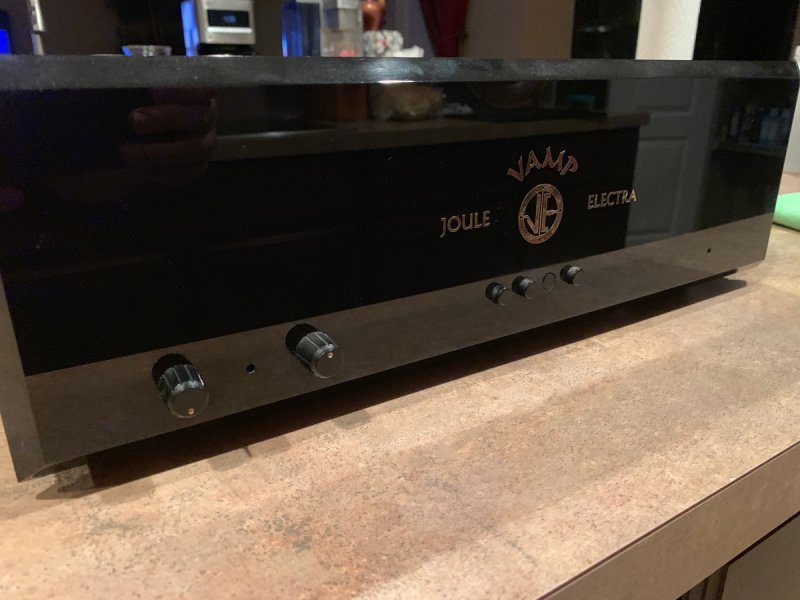
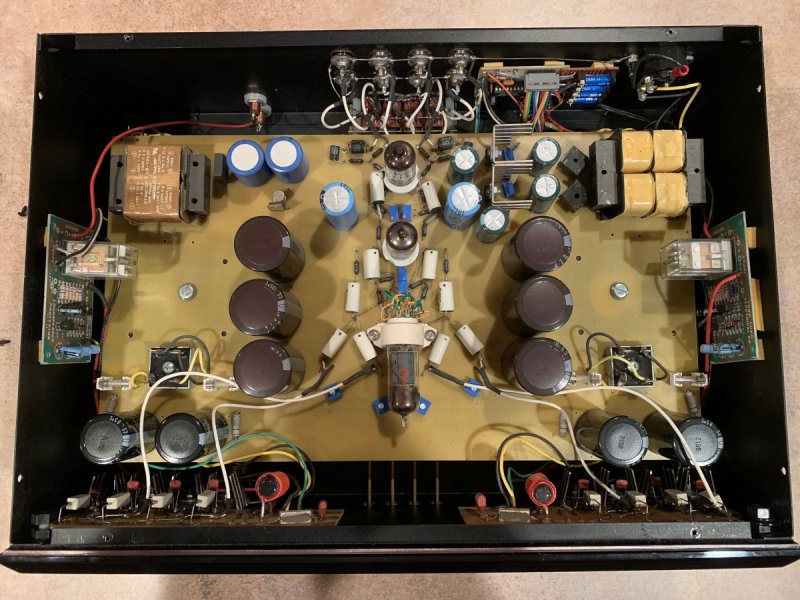
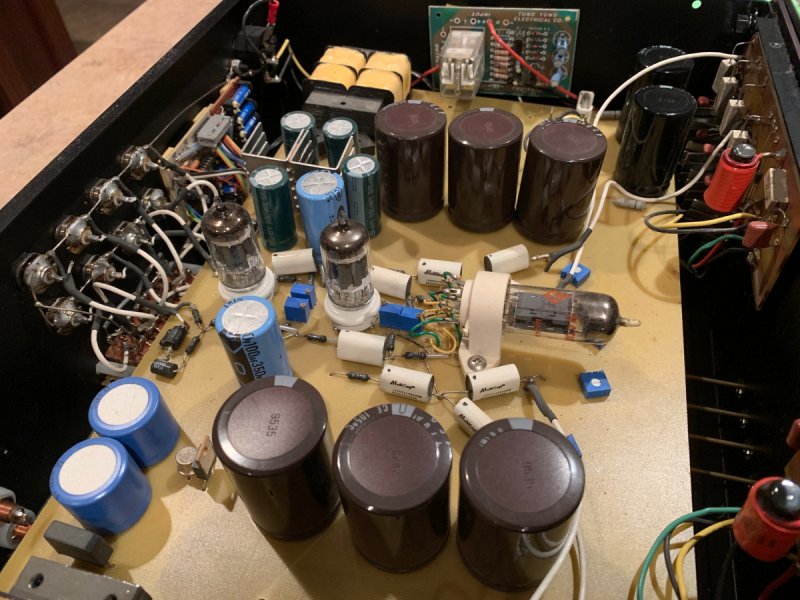
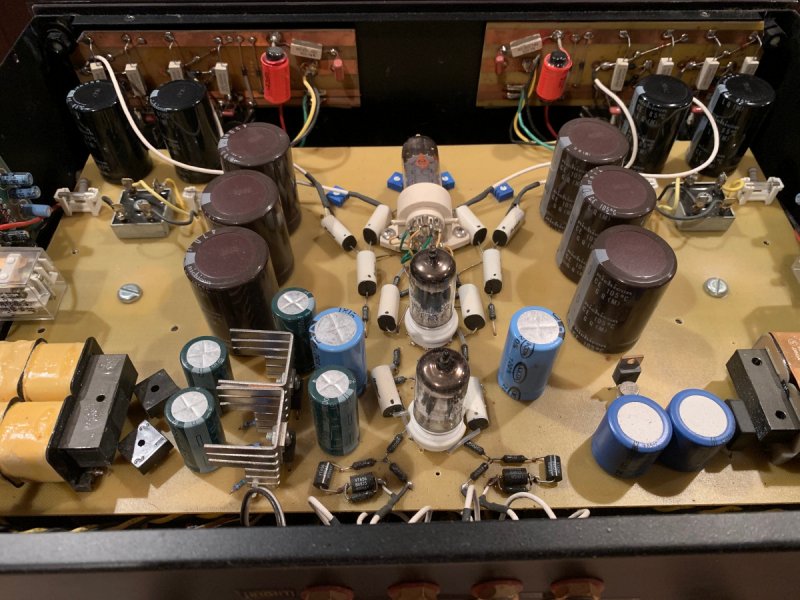
Along the way, I'd played with various solid state stuff, CODA, Marantz, Krell... some other tube gear. Nothing remarkable about the solid state stuff (yet), and
just because something had tubes in it was no guarantee it sounded good. Not like my Joule Electra stuff.
So... as my willingness and ability to put more money into stuff I wanted, I really started looking at "why" certain things I liked sounded better. And one thing I have hit on that has lead me to buy a particular set of gear is this:
Zero Global Negative FeedbackYear before last, I took a flyer on buying an Ayre Acoustics VX-5 Twenty amp. I had been reading a lot of the thoughts of Charlie Hansen, founder of Ayre. Charlie was a "tube guy", but he didn't like the hassle of tubes. His quest was to get the reliability of solid state and the magic of tubes. He started hitting on 2 things, and it's fundamental to Ayre gear:
- Zero Negative Feedback
- Fully Differentially Balanced
He became convinced that he'd just about gotten "there"...i.e., solid state reliability / ease of use with the musicality of tubes. Charlie was a very opinionated guy (he passed years ago from complications from a cycling accident). He couldn't explain exactly "Why" he thought the secret was in Zero Negative Feedback, but he thought it may have had to do with "Time Alignment" of the signal. "Timing being smeared". Now, where else have we heard commentary about "Timing and Smearing"? I believe Danny has hit on this?
So, finding that the Ayre VX-5 Twenty sounded "right" and "musical" to me, I then acquired an Ayre KX-5 Twenty preamp. Then an Ayre QB-9 Twenty DAC. Things got better and better. The KX-5 Twenty preamp is AWESOME. Everything I run is via balanced connections.
So, my current, preferred setup is this:
- Ayre QB-9 Twenty DAC
- Ayre KX-5 Twenty Preamp
- Ayre VX-5 Twenty Amp
I ABSOLUTELY LOVE IT. The retail pricing on this stuff is up there... but I buy stuff "used and right". Remember, what something actually costs you is the difference between what you buy it for and what you sell it for. This financial strategy is fully "Audiophile Approved". (Plus, it's true - notwithstanding the opportunity costs of earning on the money). But this stuff adds enjoying to my life every day... put a number on
that.In fact, I've picked up some other Ayre gear that is "secret stuff"... "secret, really good stuff that doesn't cost a fortune".
1)
AX-7e Integrated. It can be an integrated, but also has a "Pass Thru" function, so it can "just be an amp". Plus, with the way it's designed, the volume "wakes up" to make an adjustment, then "goes back to sleep". And, any inputs not being used are "put to sleep". So, it's SUPER quiet... as is all Ayre gear. $1,250 used. 60w/Ch 8ohms / 120wCh 4ohms. And... it "punches above its weight".
2)
K5xe MP preamp. This is less than half price (used) of my KX-5 Twenty preamp. But is REALLY good. It is reference quality... ~$2100 used. This is a "classic" piece.
So, that's what I use and why I use it. The thing is, "Zero Negative Feedback" in solid state stuff is not common. I also happen to think that it's a big reason why a lot of other solid state gear sounds "pretty much the same". I wanted something different and designed differently, for a reason.
A thing about lack of negative feedback... it may not measure as well / it's harder to get it to measure well. So, if something doesn't measure as well when there isn't as much feedback being employed, why do it? Why even bother with it? Why argue with people are are convinced that "measurements are the only thing that matter and if you think otherwise, you are just kidding yourself". In other words, why argue with the crowd at ASR (I don't bother).
Well, the reason is, many people think gear with less global negative feedback SOUNDS BETTER. And I completely agree with that.
And here's the thing... even if it "doesn't sound better"... it doesn't matter. I think it DOES sound better... it is a visceral reaction. When something I hear is "right"... I just "know it's right". When something is missing... I quickly get bored with it... something is missing... this is boring me.
Some will say, but the measurements! You're just mentally kidding yourself! To that I would ask:
How do you know you're measuring the right thing? In fact, I think the full commitment to "measurement above all else" is actually not "the intellectual approach" to this (although certainly could be the arrogant approach). I think it is the less enlightened approach because it ignores the fact that of "the unknown unknowns..." How do you know you know everything about what is being measured, what is / isn't being account for? They don't.
Another issue with a lot of Feedback / High Damping factor... I have found it can sap the "magic" from the presentation. Some may think, "but isn't it a great idea to control the drivers with a lot of dampening factor?" Well, why isn't "Servo Control amp" an idea being pushed for Midrange / Tweeter drivers? I would suggest it's because it's not needed... I want the midrange to bloom. Yet, it can be argued to use it to control the higher moving mass of a heavier woofer cone. So, higher feedback / higher damping factor... can lead to a "thinner sound"... less feedback / lower damping factor... more "bloom", more "magic"... more like "tubes".
But here's another thing... I am not closed minded about my current approach. The guy who bought my Magnepan 3.7i INSISTED that I listen to a DAC he brought me when he picked up the speakers. He left it with me. It was a Gustard X16. Well, it was soft and lifeless... and when I looked it up on the ASR "Master List", it ranked as one of their top DACs. Go Figure. Measurements aren't everything, for me.
Another thing I am playing with... it's a piece of "studio" gear - RME ADI-2 DAC FS. REALLY COOL! It's a DAC, it's a Preamp, it's a 5 band PEQ. It's a ton of fun to play with and so versatile. I've got it in and out of "The Big Rig". I don't see it going anywhere because it's just so flexible (and I like how it sounds too). The one I have is a "pre fire" unit with AKM4493 DAC chip.
Another example of being "open to new things"... and something I am very interested in trying. Something that you may even like to try with your NX-Otica, given the sensitivity. Have a look at the upcoming Schiit Audio Aegir 2. Why? Well... Jason Stoddard is playing with the "controversial" topic of less negative feedback. The new Aegir 2 will have a Damping Factor of 10!. Output Impedance of .8ohm! (Damping Factor = 8ohm / Output Impedance) Find another solid state amp with that kind of low damping factor... for $899! As soon as it's available, I am ordering one. I want to try it... see if I like it... learn a bit more about "the path" I'm on. Here's my hunch about the Aegir 2... I think it is going to be crazy good. It will be 25w/ch into 8ohm, 50w/ch into 4ohm. They can be run as a pair of mono at 100w/ch. It just seams like a potentially very high sound quality option for the higher sensitivity NX speakers, for (relatively) very little money.
Another interesting thing about the topic of Negative Feedback / Schiit / Jason Stoddard. I shared quite a bit about this "zero negative feedback thing" on his forum thread... and he became VERY annoyed with me... saying that "it wasn't the one truth"... and then a few weeks later announced an amp in Aegir 2 that had the qualities I was touting!!! HA! In the description of the amp / negative feedback, he refers to it as "controversial" - which I found very odd. But I think I understand why he said that... it's because he has to "play the measurement game" and straddle the fence with the pitchfork measurement crowd over at ASR. But why would Jason Stoddard take this potential criticism on? Why deal with that potential hassle with the original Aegir is already said to sound pretty good. Well, he said it himself regarding Aegir 2 and it's key "Halo Feedback" feature:
"It sounds better." (Evidently something sounding better is "Controversial"). Imagine having to placate this stuff when trying to design gear that sounds better?
So, those are my brief thoughts on this matter. Hopefully it helps.
